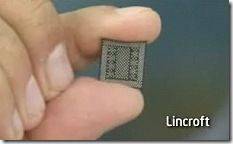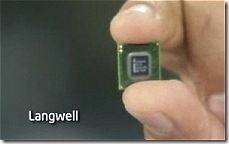Lincroft is the ‘system on chip’ that powers Moorestown, Intel’s next-gen Mobile Internet Device platform. CPU, GPU, video decode hardware, video encode hardware [Note: Try finding that on the average laptop. Justin.tv needs to watch closely!] and 2D video hardware. Langwell is the comms silicon that connects Moorestown to all the peripherals that are required in a Mobile Internet Device. Its the USB bus, the audio bus, serial, video, etc etc. Think of Moorestown as the bare motherboard which comes pre-loaded with Lincroft, the combined CPU, Northbridge and video card, and Langwell as the Southbridge which provides all the comms interfaces. On to Morestown, OEMs will add memory, power circuitry, comms chips, audio chips, BIOS, storage, cams, mics, speakers and everything else that’s required to make a MID. Hopefuly it all gets wrapped up in an exciting bit of industrial design and loaded with top quality software!
You can see Moorestown demo’d, kind of, on the video that Engadget got hold of today.
And what about that ’10x lower idle power’ figure that keeps being mentioned? Well, it means that the platform, that’s Moorestown, will idle nicely. Like a smartphone. All-day. The software will need to be developed such that it powers down all those peripherals that aren’t needed though and as for total system power drain (i.e. How long will a device last on a 10wh battery) I’m afraid its an unknown right now. Moorestown will account for a significant power saving but if an OEM goes and slaps a 2W WiFi module on it…
Intel have the same problems as all smartphone manufacturers now. It’s about guiding the OEMs and software developers and giving them the right components from the MID ecosystem.
I didn’t ever expected to be covering voice-capable devices on UMPCPortal but it looks like that’s the way it’s going!













Put it in the awesome LG XNote B831 !!!
Comon LG,LG means Life’s Good,so be it !
xD
heh, the difference between a computer and a phone these days are simply a question of built in microphone or not ;)
and this looks interesting indeed. but i really do want to know the price of the products that will be based on these…
imo both the tabletpc and the umpc priced itself out of market, and the netbooks are heading the same way :(
I have been saying many times, a X86 smartphone chip is a must for UMPC and MID to go live. Intel finally realized it. This is only half the story though. Meanwhile MS has to build a new OS that can run Windows apps and also support low-power, always-online functions for push email and phone ring.
Will MS want to do that? On one hand, it may kill its Windows Mobile OS. On the other hand, it is a must for MS to survive other than wasting resources to build the garbage like Vista.
MS simply has to do something special with WM7. Forget Vista or Windows 7. If WM7 is good and offers FIE on a large and external screen, i’ll be able to use it as my desktop!
so i guess in the end, it all comes down to the browser…
in other words, the browser is as important, or maybe even more so, as the os itself…
10x…
compared to a Intel Core2 Duo laptop running @ 45 Watts, that would translate to a 4,5Watt device.
Compared to an Atom netbook @ 14W that’d be 1,4W.
though the guy talking in the video had a previous meeting where he mentioned a “1 Watt device”.
This could be where he was talking about.
Add to the 1Watt a 1,5Watt wifi, a 2W OLED design screen, and your system will be running well below 5Watts!
The powerdraw on USB devices will be higher than whatever the CPU is using inside…
[quote]Moorestown will account for a significant power saving but if an OEM goes and slaps a 2W WiFi module on it…[/quote]
I just read some USA and international rules and regulations about this, and seemingly there’s a rule that states any small electronic device in the bandrange of 2.400 and 2.483,5 Mhz (which is regular 802.11 b/g/n networks) is allowed to transmit upto 1Watts of power.
This going from cellphones, laptops, electric devices like nettops and those tiny internet devices, as well as wireless routers.
So good news for the battery freak.
However applying a good and solid antenna could improve wireless signal.
Wireless N needs 3 antenna’s, where if 2 would be worked in the screen you’d have a good and fast connection!